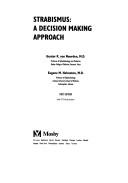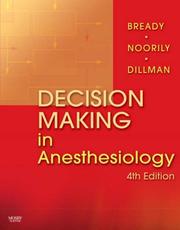| Listing 1 - 10 of 65 | << page >> |
Sort by
|
Book
ISBN: 9789175193465 Year: 2014 Publisher: Linkopings Universitet
Abstract | Keywords | Export | Availability | Bookmark
 Loading...
Loading...Choose an application
- Reference Manager
- EndNote
- RefWorks (Direct export to RefWorks)
This thesis by Mike Gerdes explores predictive health monitoring systems for aircraft using decision trees. It addresses the significant costs associated with unscheduled aircraft maintenance and proposes methods to forecast potential failures, enhancing efficiency for operators. The work integrates system monitoring, time series forecasting, and a combined approach to create a comprehensive monitoring process. Decision trees, optimized through genetic algorithms, are used to improve predictive accuracy and allow for human adjustments. The research is aimed at reducing maintenance-related delays and costs, primarily targeting aviation industry professionals and researchers in predictive maintenance technologies.
Predictive analytics. --- Decision trees. --- Predictive analytics --- Decision trees
Book
ISBN: 042995090X 0429489102 0429950896 Year: 2018 Publisher: Boca Raton, FL : CRC Press, an imprint of Taylor and Francis,
Abstract | Keywords | Export | Availability | Bookmark
 Loading...
Loading...Choose an application
- Reference Manager
- EndNote
- RefWorks (Direct export to RefWorks)
Behavior Trees (BTs) provide a way to structure the behavior of an artificial agent such as a robot or a non-player character in a computer game. Traditional design methods, such as finite state machines, are known to produce brittle behaviors when complexity increases, making it very hard to add features without breaking existing functionality.? BTs were created to address this very problem, and enables the creation of systems that are both modular and reactive. Behavior Trees in Robotics and AI: An Introduction provides a broad introduction as well as an in-depth exploration of the topic, and is the first comprehensive book on the use of BTs.This book introduces the subject of BTs from simple topics, such as semantics and design principles, to complex topics, such as learning and task planning. For each topic, the authors provide a set of examples, ranging from simple illustrations to realistic complex behaviors, to enable the reader to successfully combine theory with practice.Starting with an introduction to BTs, the book then describes how BTs relate to, and in many cases, generalize earlier switching structures, or control architectures. These ideas are then used as a foundation for a set of efficient and easy to use design principles. The book then presents a set of important extensions and provides a set of tools for formally analyzing these extensions using a state space formulation of BTs. With the new analysis tools, the book then formalizes the descriptions of how BTs generalize earlier approaches and shows how BTs can be automatically generated using planning and learning. The final part of the book provides an extended set of tools to capture the behavior of Stochastic BTs, where the outcomes of actions are described by probabilities. These tools enable the computation of both success probabilities and time to completion.This book targets a broad audience, including both students and professionals interested in modeling complex behaviors for robots, game characters, or other AI agents. Readers can choose at which depth and pace they want to learn the subject, depending on their needs and background.
Robots --- Decision trees. --- Control systems.
Book
ISBN: 9782753577107 2753577102 Year: 2019 Publisher: Rennes: Presses universitaires de Rennes,
Abstract | Keywords | Export | Availability | Bookmark
 Loading...
Loading...Choose an application
- Reference Manager
- EndNote
- RefWorks (Direct export to RefWorks)
Les forêts aléatoires sont une méthode d'apprentissage statistique qui fait aujourd'hui partie des outils centraux des statisticiens ou autres data scientists. Introduites par Leo Breiman en 2001, elles sont depuis intensément utilisées dans de nombreux domaines d'application (comme par exemple l'écologie, la prévision de la pollution ou encore la santé), du fait des très bonnes performances de l'algorithme en prédiction, mais aussi de leur généralité, n'imposant que très peu de restrictions sur la nature des données. En effet, elles sont adaptées aussi bien à des problèmes de classification supervisée qu'à des problèmes de régression. De plus, elles permettent de prendre en compte un mélange de variables explicatives qualitatives et quantitatives. Enfin, elles sont capables de traiter des données standard pour lesquelles le nombre d'observations est plus élevé que le nombre de variables, mais se comportent également très bien dans le cas de données de grande dimension où le nombre de variables est très important. Ce livre est une présentation statistique des forêts aléatoires, orientée vers les applications. Il s'adresse donc en premier lieu aux étudiants de filières comportant des enseignements de la statistique mais aussi bien entendu aux praticiens du domaine. Pour fixer les idées sur le plan pédagogique, un niveau de licence scientifique est tout à fait suffisant pour tirer profit des concepts, méthodes et outils introduits. Sur le plan informatique, les pré-requis sont modestes mais une initiation au langage R est utile pour s'approprier pleinement l'usage des forêts aléatoires.
Decision trees --- Mathematical statistics --- Data processing

ISBN: 0815140487 Year: 1994 Publisher: Saint Louis (Ill.) : Mosby,
Abstract | Keywords | Export | Availability | Bookmark
 Loading...
Loading...Choose an application
- Reference Manager
- EndNote
- RefWorks (Direct export to RefWorks)
Decision Trees. --- Strabismus --- Strabismus. --- Diagnosis. --- Therapy.
Book
Year: 2019 Publisher: Reston, Virginia : U.S. Department of the Interior, U.S. Geological Survey,
Abstract | Keywords | Export | Availability | Bookmark
 Loading...
Loading...Choose an application
- Reference Manager
- EndNote
- RefWorks (Direct export to RefWorks)
Geodesy. --- Decision trees. --- Astronomy --- Earth (Planet)
Book
ISBN: 9068092553 Year: 1997 Publisher: Utrecht Koninklijk Nederlands aardrijkskundig genootschap
Abstract | Keywords | Export | Availability | Bookmark
 Loading...
Loading...Choose an application
- Reference Manager
- EndNote
- RefWorks (Direct export to RefWorks)
Decision trees --- Housing --- Rental housing --- Economic aspects
Book
ISBN: 3736926618 Year: 2008 Publisher: Gottingen, [Germany] : Cuvillier Verlag,
Abstract | Keywords | Export | Availability | Bookmark
 Loading...
Loading...Choose an application
- Reference Manager
- EndNote
- RefWorks (Direct export to RefWorks)
Machine learning. --- Automatic classification. --- Decision trees.

ISBN: 9780323070669 0323070663 9780323039383 0323039383 Year: 2007 Publisher: [Place of publication not identified] Mosby Elsevier
Abstract | Keywords | Export | Availability | Bookmark
 Loading...
Loading...Choose an application
- Reference Manager
- EndNote
- RefWorks (Direct export to RefWorks)
Anesthesia --- Algorithms --- Decision Trees. --- Perioperative Care --- Decision making --- methods. --- Decision Trees --- methods --- Algorithms. --- Decision making.

ISBN: 0815124554 Year: 2000 Publisher: Saint Louis Mosby
Abstract | Keywords | Export | Availability | Bookmark
 Loading...
Loading...Choose an application
- Reference Manager
- EndNote
- RefWorks (Direct export to RefWorks)
Anesthesia --- Decision Trees. --- Perioperative Care --- Decision Tree --- Tree, Decision --- Trees, Decision --- methods. --- Decision making. --- Methods. --- Decision Trees --- Anaesthesia --- Anesthesiology --- Analgesia --- Decision making --- methods

ISBN: 9780323039383 9780323070669 0323070663 0323039383 Year: 2007 Publisher: [Place of publication not identified] Mosby Elsevier
Abstract | Keywords | Export | Availability | Bookmark
 Loading...
Loading...Choose an application
- Reference Manager
- EndNote
- RefWorks (Direct export to RefWorks)
Algorithms. --- Anesthesia --- Decision Trees. --- Perioperative Care --- Decision making. --- methods. --- Algorithms --- Decision Tree --- Tree, Decision --- Trees, Decision --- Algorism --- Algebra --- Arithmetic --- Anaesthesia --- Anesthesiology --- Analgesia --- Decision making --- Foundations --- Decision Trees --- methods
| Listing 1 - 10 of 65 | << page >> |
Sort by
|

 Search
Search Feedback
Feedback About UniCat
About UniCat  Help
Help News
News